We’ve been talking interdisciplinary collaboration, data-visualisation and sustainability for two intense days at the Making Visible The Invisible conference in Huddersfield at the University of Huddersfield, School of Art, Design and Architecture. Organized by Michael Hohl, Making Visible The Invisible was a conversational conference that didn’t suffer any paper presentation. Instead, we met in small groups to discuss a series of topics then reported back in a common sessions. The process was nevertheless interrupted by keynote presentations. One of the most engaging was the one that Andrea Polli gave on the first evening of the conference.
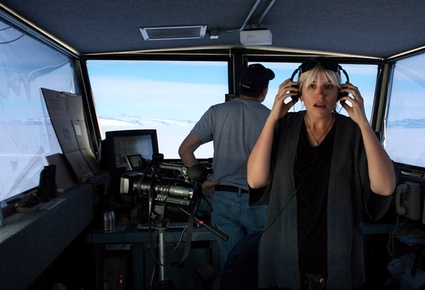 Andrea Polli (image via Ear Room)
Andrea Polli (image via Ear Room)
Andrea Polli is a digital media artist living in New Mexico. Her work with science, technology, and media has been presented in exhibitions and performances internationally. She currently works in collaboration with atmospheric scientists to develop systems that provide an understanding of storm and climate through sound. Her agenda is chock full of residencies and participation to exhibitions all over the world. I’m glad that she’s going to have a solo show here in Turin at the Parco Arte Vivente on October 28-Jan 8, 2011.
Her talk in Huddersfield, titled, “Who Owns The Air? Emissions Trading and Contemporary Media Art”, mixed presentation of her personal work, contemporary projects by other artists that attempt to address the politics of air as well as information and thoughts on the climate change crisis.
The accelerating crisis in climate change and the realization that humans are the primary cause of this change has raised questions about ownership and responsibility. Who “owns” the climate change crisis and who is responsible for mitigating and reversing it if possible? One overwhelming response by governments on an international level has been to propose a market solution, in essence, to sell the atmosphere. Is the commercial marketplace the only answer? How can art, technology and media offer alternative cultural practices and open new forms of understanding the air?
The largest market-based approach to control greenhouse gases is the European Union Emission Trading Scheme. Launched in 2005 as part of the EU climate policy, the scheme requires large emitters of carbon dioxide to report their CO2 emissions, and return an equivalent amount of emission allowances to the government.
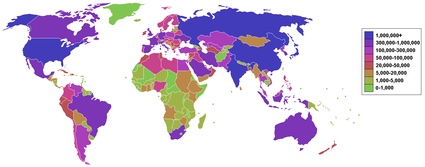 Countries by carbon dioxide emissions map (via)
Countries by carbon dioxide emissions map (via)
Where does the idea of a market-driven solution to the problem of air pollution come from? The attention to the concept of ownership has gained momentum in the 20th century with the publication of The Tragedy of the Commons, an essay written by Garrett Hardin and first published in the journal Science in 1968. Someone in the audience informed us that Hardin retracted the article when he realized that corporation used his essay as a justification to privatize everything they wanted to gain profit from.
Part of the model for the EU carbon trading scheme is the US cap-and-trade in sulfur dioxide, a market-based initiative launched to reduce overall atmospheric levels of sulfur dioxide and nitrogen oxides, which cause acid rain. The program primarily targets coal-burning power plants, allowing them to buy and sell emission permits (called “allowances”) according to individual needs and costs. It was successful because it was low-cost and easy to implement.
Other models that could be applied to carbon dioxide:
– right of the airwaves. In the US, airwaves are sold by auction. It’s the highest bidder who gets them.
– Noise codes (who has the right to make noise). A few years ago, New York city reviewed its noise code. Noise complaints are indeed the number one quality of life issue for New York City residents.
– air is already marketed but on a personal level in oxygen bars. Canned versions of oxygen are even sold in Japan’s 7/11.
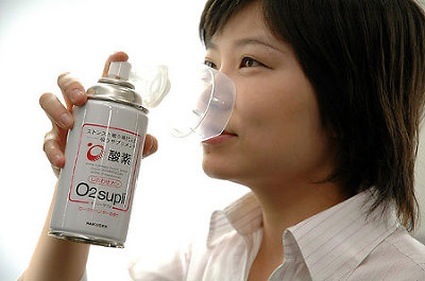
Artists might be partly responsible for this acceptance of air as a commodity.
From 1957 to 1962, Yves Klein imagined the Architecture of Air. My walls of fire, my walls of water, like the roofs of air, are materials for the construction of a new architecture. With these three classical elements, fire, air, and water, the city of tomorrow will be constructed, flexible at last, spiritual and immaterial. (Yves Klein, conférence de la Sorbonne.)
The late ’60s also saw a dematerialization of art. Take the Inert Gas Series for example. On March 1969, Robert Barry released a litre of krypton into the atmosphere, in Beverly Hills. Over the following days, he released xenon in the mountains, argon on the beach and helium in the desert. All we have left of this artwork are a series of pictures that don’t show much.
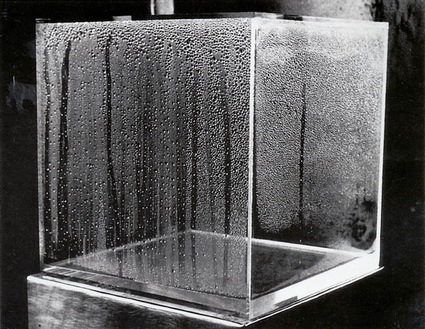 Hans Haacke, Condensation Cube, 1963-65
Hans Haacke, Condensation Cube, 1963-65
For his work Condensation Cube, Hans Haacke used a biological system to create a work that depends entirely on the fluctuations in room temperature. The artist placed a small amount of water inside a sealed Perspex box. As the cube warms up, the water condenses on the inside walls. It then runs down to collect on the bottom, and the whole process is repeated again and again.
“When art becomes ideas ideas become commodities.”
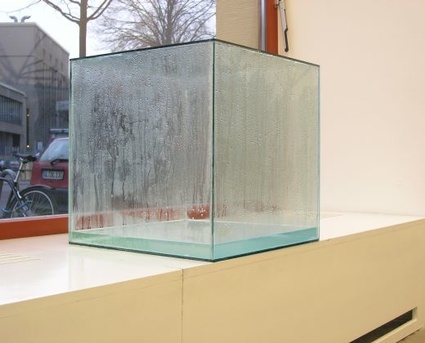 Tue Greenfort, BONAQUA Condensation Cube, 2005
Tue Greenfort, BONAQUA Condensation Cube, 2005
40 years later, Tue Greenfort paid homage to Haacke’s Condensation Cube with BONAQUA Condensation Cube. By filling the cube with bottled mineral water from the Bonaqua label, Greenfort points to the global trading of a limited resource. The company is said to have destroyed local agriculture in 2004 by privatizing parts of India’s water resources. In Plachimada, Kerala, Coca-Cola extracted 1.5 million liters of deep well water, which they bottled and sold under the names Dasani and BonAqua. The groundwater was severely depleted, affecting thousands of communities with water shortages and destroying agricultural activity. The remaining water became so contaminated with high chloride and bacteria levels that the local population suffered from a series of health problems and the area was affected by environmental damage (via).
Artists have adopted several strategies to address the politics of air:
Strategy 1 – Public Commissions and Activism
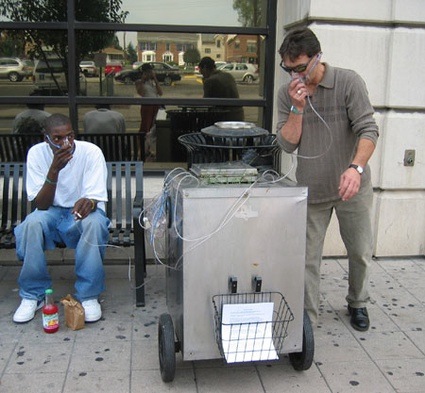 A. Laurie Palmer, Oxygen Bar, 2004-2005. Photo A. Laurie Palmer
A. Laurie Palmer, Oxygen Bar, 2004-2005. Photo A. Laurie Palmer
A. Laurie Palmer’s Oxygen Bar is a mobile breathing machine, offering free oxygen produced by the photosynthetic work of green plants (from Hays Woods.) Pushed around the streets of Pittsburgh, the bar attempted to reproduce in miniature the beneficial cleansing and refreshing effects of city green spaces on the air we breathe.
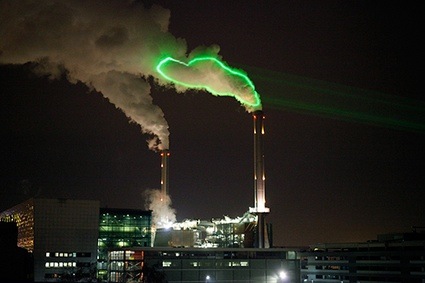 HEHE, Nuage Vert in Ivry-sur-Seine, 2010
HEHE, Nuage Vert in Ivry-sur-Seine, 2010
Other projects Andrea Polli referred to in this part of her talk are the famous Nuage Vert (Green Cloud), by HEHE as well as the Blur building by Diller and Scofidio.
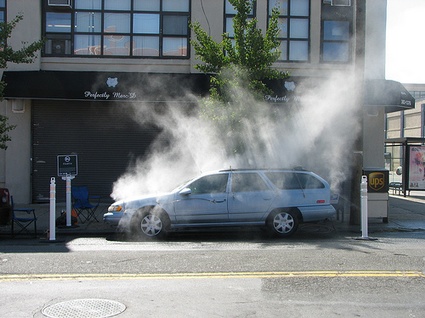 Andrea Polli & Chuck Varga, Cloud Car, 2009
Andrea Polli & Chuck Varga, Cloud Car, 2009
She added her own work Cloud Car to the list. Cloud Car visualizes in a spectacular way the emissions of your vehicle. A car fitted with special effects equipment is left in the street to produce a cloud of mist, enveloping car, rider and passersby. Guides stationed near the car, distribute fact sheets related to air quality issues and encouraging people to discuss the environment, automobiles and traffic in the city.
Another of her project, Breather, wraps up a car inside a plastic bag to illustrate the problem of air pollution in New Delhi India, where one person dies every hour from breathing complications. The quality of the air is so bad that walking in some areas of the city is the equivalent for your health to smoking 15 cigarettes in a day. In this work, a car is encased in a plastic bubble that inflates and deflates at a rate similar to human breathing. The car used is one of the most widely owned in India. That model has now been discontinued because of the excessive amount of pollution it generates.
Strategy 2 – Working with agencies to communicate data about air quality
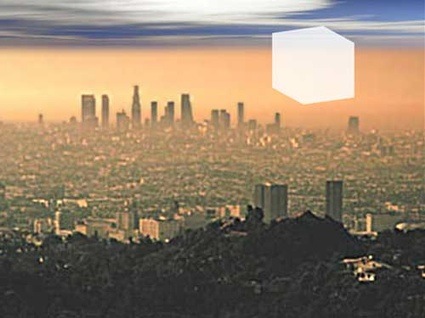 Amy Balkin, Public Smog
Amy Balkin, Public Smog
Among the examples that Polli mentioned is Public Smog by Amy Balkin. The artist bought and withheld carbon gas emission credits from international trading markets in order to create a temporary clean-air park in the atmosphere that fluctuates in location and scale. The park opened above the region where offsets are purchased and withheld from use. The project involved also an attempt to submit the Earth’s atmosphere for inscription on UNESCO ‘s World Heritage List.
Ben Engebreth‘s Personal Kyoto allows New York ConEd customers to track their residential or commercial electric usage and work towards the goal of decreasing that usage. The project points the finger at George W. Bush who backed out of the Kyoto treaty as soon as he became President.
 Andrea Polli, Airlight Taipei
Andrea Polli, Airlight Taipei
During a residency in Taipei, Polli collaborated with Dr. Chung-Ming Liu to develop Airlight Taipei, a networked real-time sound and visual installation using data from an EPA air-quality monitoring station in central Taipei indicating various air pollutant levels.
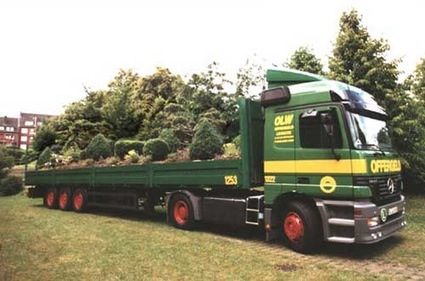 Eve Andree Laramee, Parks on Trucks, Project for the City of Aachen, 1999
Eve Andree Laramee, Parks on Trucks, Project for the City of Aachen, 1999
For Parks on Trucks: Project for the City of Aachen artist Eve Andree Laramee worked with bio-geographer Duane Griffin to plant parks on three Mercedes-Benz flat-bed trucks that circulated through Aachen, Germany.
A first truck was planted with a topiary garden as a reference to “artificial nature”. The second one hosted medicinal and poisonous plants. The third truck, planted with a small crop of corn, polluted the environment and cleaned the air at the same rate by equating carbon dioxide removed from the atmosphere by the corn plants with the amount of carbon dioxide emitted into the atmosphere as exhaust as the truck moves around the city. The experiment lasted three months. During that period of time, the truck covered only a distance of one third of a kilometer. The project raised several issues, one of them was corporate “greenwashing”, where companies such as Mercedes-Benz use nature images in their advertising strategies.
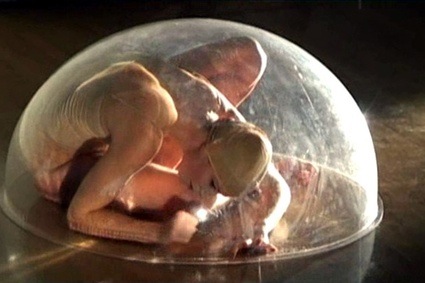 Sarah Jane Pell, Undercurrent, 2007
Sarah Jane Pell, Undercurrent, 2007
For her performance Undercurrent, Sarah Jane Pell is enclosed in a bubble containing 16 minutes of air.
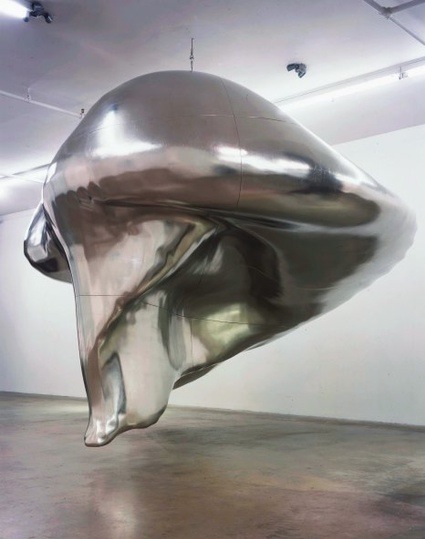 Iñigo Manglano-Ovalle, Cloud Prototype No.1, 2003
Iñigo Manglano-Ovalle, Cloud Prototype No.1, 2003
Cloud Prototype No. 1, by Iñigo Manglano-Ovall, freezes a thunderstorm that erupted over Missouri and then progressed into southern Illinois. The storm was captured as 3D data by the Department of Atmospheric Sciences at the University of Illinois, Champaign-Urbana.
Strategy 4 – Community Science
Preemptive Media‘s portable AIR (Area’s Immediate Reading) kits allow citizens to measure and record exposure to pollutants in the area where they live such as carbon monoxide, sulfur oxides, nitrogen dioxide, lead and noise.
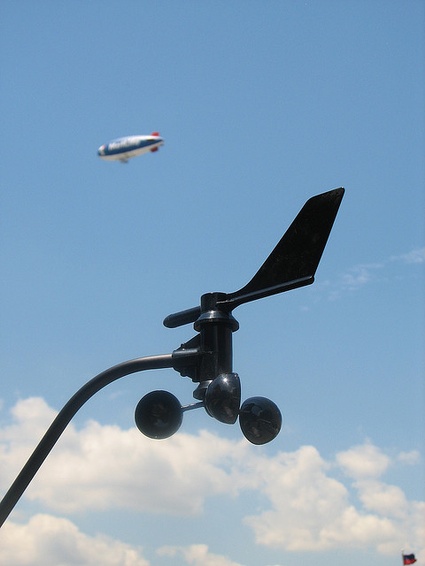 Hello Weather! (image Andrea Polli)
Hello Weather! (image Andrea Polli)
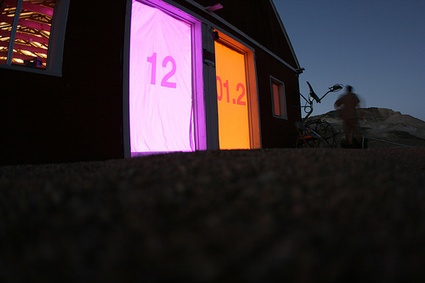 Hello Weather! (image Andrea Polli)
Hello Weather! (image Andrea Polli)
Hello Weather!, another of Andrea Polli and Chuck Varga’s projects, builds on the phenomenon of Personal Weather Stations in which enthusiasts combine DIY technology with organized web forums for collecting and analyzing data. The project invites artists and others to engage with the real-time data and other information available here in a variety of formats.
Five wireless, solar powered Professional Weather stations are currently in operation: two in New York City, one in Los Angeles, one in Zurich and one in New Delhi.
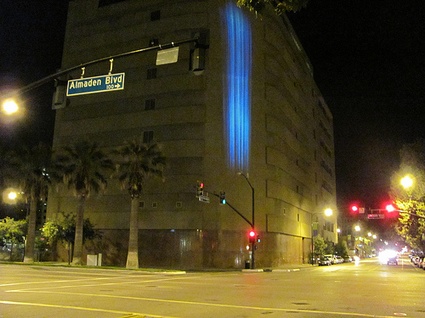 Particle Falls (image by Andrea Polli)
Particle Falls (image by Andrea Polli)
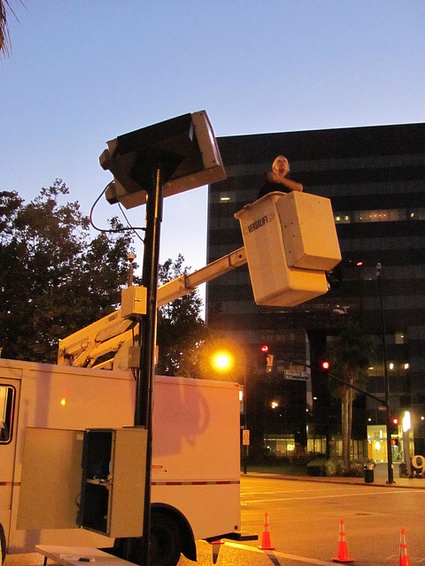 Particle Falls (image by Andrea Polli)
Particle Falls (image by Andrea Polli)
More recently, Andrea Polli was invited to create a public piece for San Jose. Particle Falls visualizes Particulate Matter 2.5, subdivisions of solid matter suspended in the air we breathe. They are so tiny that they have been detected only recently. PM pollution is estimated to cause 22,000-52,000 deaths per year in the United States (from 2000) and 200,000 deaths per year in Europe. The number of people that airborne particulate pollution kills each year has tripled in California.
Particulate pollution might be invisible to us but it can be measured by laser light scattering. One of those lasers was given to the artists. Particle Falls used a nephelometer to measure particulate matter (in particular the smallest particle, PM2.5) in the air and translated this information into the image of a “waterfall” that is projected on an eight story building. The data collected at this artwork installation demonstrates air quality in downtown San Jose and is also available on the web.
Strategy 5 – Structures allowing artists to work alongside scientists
Andrea Polli went on a seven-week National Science Foundation residency in Antarctica during the 2007/2008 season. The result of the residency is Sonic Antarctica, a radio broadcast, live performance as well as a sound and visual installation that features recordings of the Antarctic soundscape. The project mixes natural and industrial field recordings, sonifications and audifications of science data and interviews with weather and climate scientists.
More information about Polli’s experience in Antarctica in Ground Truth Antarctica, a documentary that follows weather and climate observation at the South Pole, McMurdo Station and field sites in the Dry Valleys of Antarctica and asks why people go to remote, uncomfortable and often hazardous locations, doing what is known as ‘ground truthing.’
Ground Truth from Andrea Polli on Vimeo.
Andrea Polli has a book coming soon, Far Field: Digital Culture, Climate Change and the Pole.
Image on the homepage by Andrea Polli.
